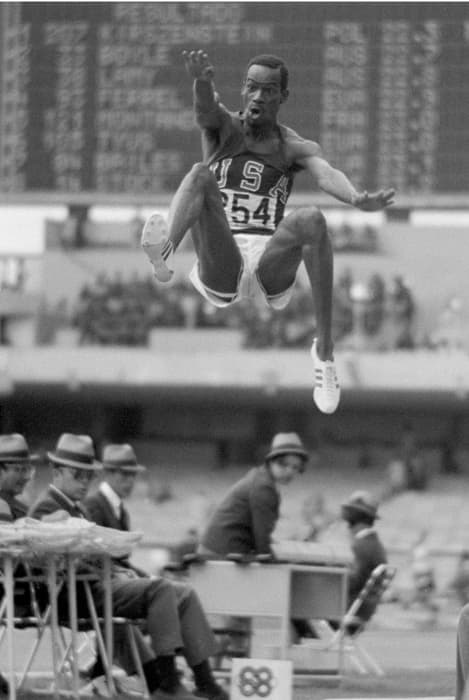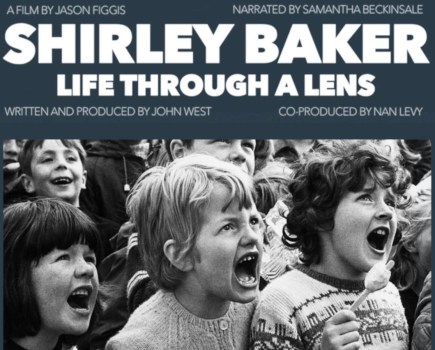Image: Bob Beamon of the USA leaps a record-breaking 29ft 2.5in (8.9m) at the 1968 Olympic Games in Mexico City © Tony Duffy/Getty Images
The 1968 Olympic Games, held in Mexico City, are remembered for the controversial ‘Black Power’ salute by American sprinters Tommie Smith and John Carlos, the first Olympic use of the ‘Fosbury Flop’ technique in the high jump and a memorable 400m hurdles gold medal for Britain’s David Hemery.
Yet one sporting triumph stands out from all the others: Bob Beamon’s record-breaking long jump, a feat that was, at the time, called ‘the leap of the century’. It was captured in one spectacular picture by British photographer Tony Duffy.

Image: British photographer Tony Duffy, who took the iconic shot of Bob Beamon © Tony Duffy/Getty Images
In 1968, Duffy, a 31-year-old accountant with a passion for sports photography, travelled to Mexico with the aim of shooting pictures that he could sell to newspapers and magazines. However, in his forthcoming memoirs (from which he has kindly allowed AP to quote in this feature), he says that looking back, he was completely under-prepared to shoot great sports pictures.
‘I had never attended a photo class in my life or even read a “How To” book on photography,’ he writes. ‘I was always in too much of a hurry to take sports photos to stop and learn how to take them… my main motivation was to be at the events, which was so much more pleasurable than my day job in an accountants’ office.’
He was shooting with a Nikkormat 35mm SLR camera that had no motordrive and needed to be manually wound on after each frame. To get closer to the action – and make himself seem more professional among the other photographers in Mexico – Duffy bought a 300mm f/4.5 Nikkor-H Auto lens.
On 18 October 1968, he arrived at the start of the afternoon session in the Olympic stadium to find it was only half-full. He had a ticket for a seat high up in the stadium, but as there were empty places further down he talked himself past the stewards into a seat in the front row. From this position, he had a head-on view of competitors in the men’s long jump.
 Image: A montage of Bob Beamon winning the long jump at the Olympic Games in Mexico City on 18 October 1968 © Bride Lane Library/Popperfoto/Getty Images
Image: A montage of Bob Beamon winning the long jump at the Olympic Games in Mexico City on 18 October 1968 © Bride Lane Library/Popperfoto/Getty Images
Commentators had predicted a close competition, with the defending champion, Britain’s Lynn Davies, keen to retain his gold medal from the 1964 Olympics. The favourite, however, was the 22-year-old American Bob Beamon, who had won 22 of the 23 previous events in which he had competed.
Beamon had only just made it into the final after two of his qualifying jumps were ruled out for overstepping, but he looked relaxed as he prepared to take his first jump of the day. ‘I felt very calm, very peaceful,’ he later said. ‘When I stood there I didn’t hear anybody. I was very much focused. When I jumped, there was nothing but quietness.’
Beamon powered along the track and attained unusual height when he jumped. ‘He hung in the air like Michael Jordan going to the basket. I remember seeing the whites of his eyes,’ Tony Duffy recalled in a 1993 interview with The Independent.
Duffy took just one image of Beamon’s jump, shot at 1/500sec at f/4.5. It showed him high off the ground, above the heads of the judges in the background. Duffy’s focus is sharp on Beamon’s head and torso; the athlete’s expression seems to register amazement at just how high and far he is travelling.
As he landed and made his way back down the track, Beamon was unaware of how far he had jumped. However, as the officials manually measured the distance with tape measures (he had leaped beyond their electronic measuring device), he began to realise he had achieved something special.
When the distance of 8.90m appeared on the display board over 30 minutes afterwards, Beamon still didn’t realise exactly how far he had jumped as he was not used to metric measurements. When he was told that his jump was a massive 29ft 2.5in – almost 22in further than the previous world record – his legs buckled beneath him.
Duffy also did not realise what he had achieved. ‘For the next two days that roll of film was in my pocket, undeveloped, while I rushed from venue to venue, savouring the excitement of my first Olympics,’ he says in his memoirs.
After dropping off the film at a one-hour photo kiosk, he collected the negatives the following day to see that the shot of Beamon was in sharp focus. ‘I still had no idea that there were only a few photos of the actual record jump and mine was the best of them,’ Duffy writes.

After returning to London, Duffy decided to send the photo to AP and it was duly published for the first time, closely cropped on Beamon, in our 4 December 1968 issue. Duffy remembers that ‘the phone started ringing as calls came in for the Beamon shot and the photo began to “fly off the shelves”. It gradually dawned on me that I had been fortunate enough to take something special.’
The success of this photograph led Duffy to give up his accountancy job in 1971 and the following year he founded the Allsport photo agency in partnership with a photographer friend, John Starr. It quickly became established as one of the world’s top sports photo agencies and remained in business until it was bought out by Getty in 1998 for £29.4 million.
Duffy, now 75, retired and living in California after a successful career in sports photography, says that his Beamon photo has probably been reproduced in ‘close to a thousand’ different publications worldwide.
The photograph transformed his life and brilliantly captures one of the great sporting achievements of the 20th century. Beamon’s world record has only been broken once (by Mike Powell, in 1991) and, 44 years on, it still remains the Olympic record.
Books and Websites
Books: Several books on sports photography featuring Tony Duffy’s pictures, including Athletics in Focus and Winning Women: The Changing Image of Women in Sport, are available at www.amazon.co.uk.
Websites: Film footage of Beamon’s record-breaking long jump can be seen on www.youtube.com (search for Bob Beamon). A selection of Tony Duffy’s more recent work can be seen on his website, www.tonyduffy.net.
Events of 1968
- 8 January: The Prime Minister, Harold Wilson, gives his approval to the ‘I’m Backing Britain’ campaign, aimed at boosting the economy. It encourages employees to work an additional half hour each day without pay
- 17 March: An anti-Vietnam War demonstration in London’s Grosvenor Square erupts in violence, with 200 demonstrators arrested and 91 people injured
- 4 April: American civil rights leader Martin Luther King, Jr, is assassinated at the Lorraine Motel in Memphis, Tennessee. Several days’ rioting follows in many US cities
- 8 May: Ronnie and Reggie Kray are among a group of men arrested in London for crimes including murder, fraud and blackmail
- 5 June: Robert F Kennedy, the democratic candidate in the US Presidential election, is shot at the Ambassador Hotel in Los Angeles, California. He dies from his injuries the following day
- 20-21 August: Czechoslovakia is invaded by around 200,000 Warsaw Pact troops and 5,000 tanks. The invasion ends the ‘Prague Spring’ of political reform
- 5 November: In the US Presidential election, Republican Richard M Nixon defeats the Democratic candidate, Hubert Humphrey







